Building bigger and impressive biceps requires more than just doing the same bicep exercises over and over again. It takes time and knowledge to build bigger biceps.
Cable machines are one of the best ways to train the biceps.
It is popular with strength training beginners thanks to its simplicity and smooth and constant tension on your bicep muscles. This leads to more time under tension and, in turn, more potential for muscle growth.
Here, we will discuss some of the best cable bicep exercises (based on science and experience) and know the best strategies and workout plans to train them.
Use Our Free Calculator To Know Your Calories Requirement To Gain Muscle Mass
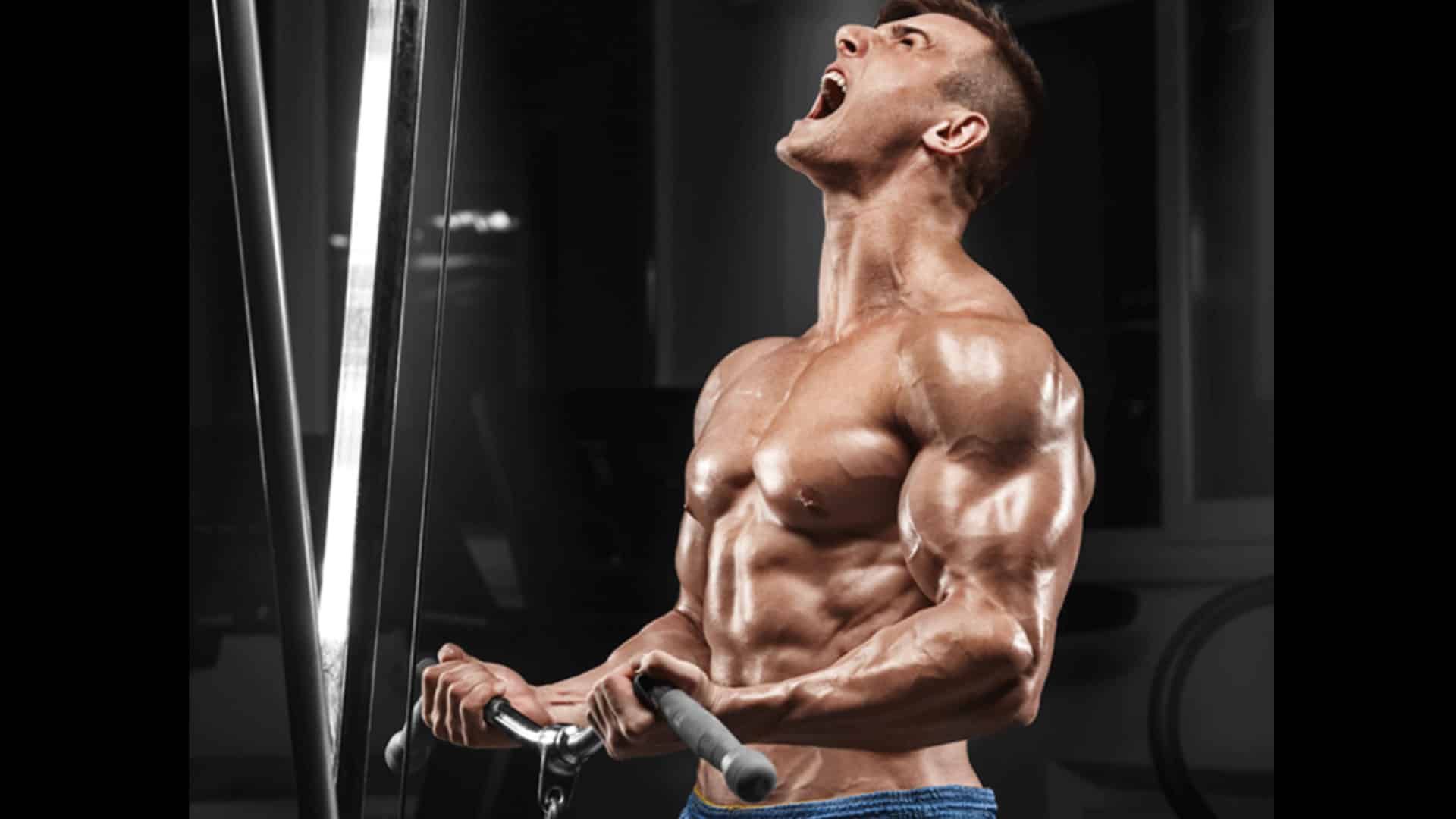
- 10 Best Cable Bicep Exercises
- 1. One Arm High Cable Curl
- 2. Cable Hammer Curl
- 3. Behind The Back Cable Curl (Bayesian Curl)
- 4. Cable Preacher Curl
- 5. Close Grip Cable Curl
- 6. Cable Reverse Curl
- 7. Cable Drag Curl
- 8. One Arm Cable Curl
- 9. Cable Squatting Curl
- 10. Lying Cable Curl
- How to Train Bicep With Cable
- 1. Training Volume (Sets And Reps)
- 2. How To Add Bicep Cable Exercises In Your Workout Routine
- 4. Cable Only Bicep Workout Routine
- 5. Bicep Workout Routine
- 6. Pull Workout Routine
- FAQ
- Are cables good for the biceps?
- Are cable workouts better than dumbbells?
- Can Bicep cable exercises build muscle?
- Why are bicep cables Workouts better?
- Are cables better for hypertrophy?
- Can you build biceps with cables?
- References & Resources
10 Best Cable Bicep Exercises
The 10 best cable bicep exercises will pump up your biceps and improve the overall function of your upper arms.
1. One Arm High Cable Curl
The High cable curl exercise is a great option for targeting the biceps and building the width and thickness of the bicep muscle.
The high cable curl has two main versions: one-arm and two-arm. Both variations are effective, but the one-arm version allows you to use more relative weight for potentially greater gains in biceps size and strength.
However, since this is an isolation exercise, it will be best to train with a light to moderate load to fully contract the biceps muscles.

How To Do
- Attach simple handles to the top of the cable pulley. Adjust the pulleys to your height from a standing position.
- Your lower arms should be parallel to the floor when your arms are fully bent.
- Hold the handles of the pulley machine from below with palms facing up.
- Start with your arms extended out to the sides.
- Keep your elbows fixed and slowly bring your hands back towards your shoulders.
- Squeeze both biceps at the top of the movement: imagine you are performing a front double biceps pose.
- Slowly return to your starting position.
- Take advantage of the resistance in the eccentric portion of the movement to help build your biceps.
2. Cable Hammer Curl
The cable hammer curl is one of the best exercises that you can do to build your arm muscles.
When it comes to building massive biceps and forearms, the rope hammer curl is an effective isolation workout that targets the brachialis and brachioradialis.
The cable rope hammer curl is a variation of the hammer curl, utilized to build the anterior muscles of the arm.
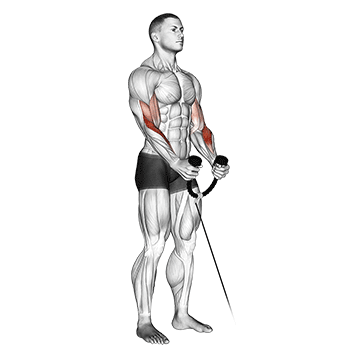
How To Do
- Attach a rope attachment to a low pulley and stand facing the machine.
- Grasp the rope with a neutral (palms-in) grip.
- Put your elbows in by your side and keep them stationary during the entire movement.
- Pull your arms until your biceps touch your forearms. Hold for a second.
- Slowly, start to bring the weight back to the original position.
- Do 8-12 reps.
3. Behind The Back Cable Curl (Bayesian Curl)
The Behind-the-Back Cable Curl, also known as the Bayesian curl, is the same concept as the incline dumbbell curl. Your arms will curl with your elbows behind you, which emphasizes the long head.
Doing cable curls behind the body shifts the emphasis of the exercise onto the outer biceps and minimizes the chance of developing unsightly muscular imbalances. You must try this cable bicep workout.
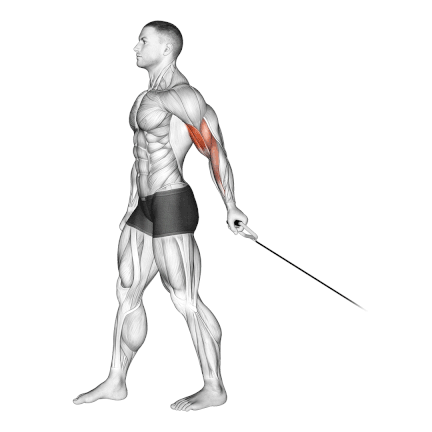
How To Do
- Connect a single cable handle to the bottom of a cable pulley.
- Grab the handle with an underhand grip and then face away from the machine.
- Take a step out from the cable station and let your arm travel behind your torso until you feel a good stretch in your biceps.
- The arm is positioned and maintained behind the body throughout the range of motion.
- Curl the handle toward your shoulder by squeezing your biceps as hard as possible.
- Lower the weight back down under control until your elbow is fully extended.
- It is important to remember that the elbow should point backward at the end of the movement, as it did at the start.
- Repeat for the ideal number of reps to complete the set.
- Now, switch arms to complete the exercise on your right side, and then alternate between arms for sets.
4. Cable Preacher Curl
It combines two powerful elements: the preacher bench’s stability and the cable’s constant tension. When you do regular preacher curls with dumbbells, you lose tension at the top. But with cables, that tension stays locked in throughout.
But the best part? It’s all biceps, baby. No front delts jumping in to help, no momentum, just pure bicep activation. If you’re serious about building those peaks, this must be in your routine.
You can also perform this with different grips (e.g., straight bar, EZ bar, or rope attachment). The neutral or “hammer” grip amplifies activation of both the grip and the brachialis muscles, building arm thickness.
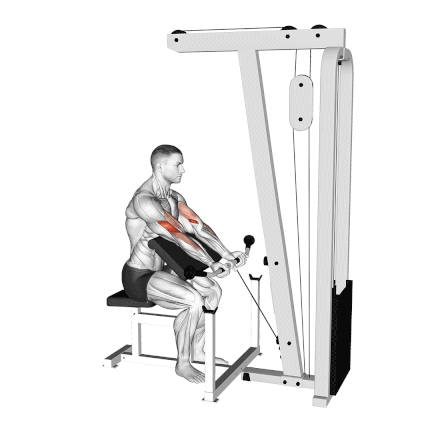
How To Do
- Position the preacher bench in front of a low cable station. Adjust the seat height so your armpits rest comfortably on the top of the pad.
- Grab the cable attachment (straight bar or EZ-curl bar works best).
- Sit with your chest tight against the pad and your arms fully extended, but don’t lock elbows.
- Curl the weight up smoothly – no jerking movements. Focus on squeezing your biceps hard.
- Keep those upper arms glued to the pad.
- Control it all the way until arms are fully extended
- Hold for a count and then lower the weight slowly.
5. Close Grip Cable Curl
The close grip bicep cable curl is one of the best isolation exercises for the long head of the bicep. It’s a pulling action performed with a cable machine and is suitable for beginners.
Many people don’t realize that this close grip position is actually more natural for your wrists. If you’ve been getting some wrist pain from regular curls, this might be your answer.
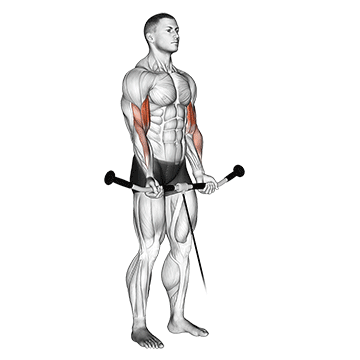
How To Do
- Set up for the cable curl by attaching a straight bar to the low pulley cable.
- Grasp the bar with an underhand grip (palms facing up), and your hands about shoulder-width apart.
- Curl the bar up toward your shoulders by bending at the elbows.
- Lower the weight down to the arm’s extended position.
- Keep the rep timing slow and control the weight as you lower it.
6. Cable Reverse Curl
The cable reverse curl, also known as the reverse cable curl, is an exercise that targets the brachioradialis muscle in the forearms, along with the biceps and other forearm muscles.
The cable reverse curl helps to balance arm development by targeting the less often targeted muscles of the forearms and brachialis. This can lead to a more proportional and aesthetic arm.
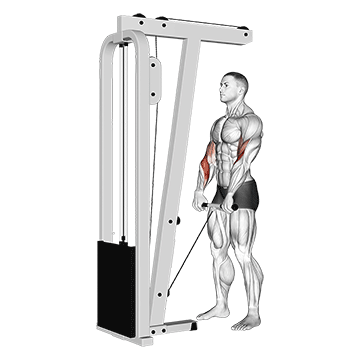
How To Do
- Stand up with your torso upright.
- Hold a bar attachment that is attached to a low pulley using a pronated (palms down) and shoulder-width grip.
- Keep your elbows in, and bring the bar up to your chest by flexing the elbow.
- Pause at the top of the movement and squeeze your biceps.
- Slowly lower the bar back down to the arms’ extended position.
- Repeat for desired reps.
7. Cable Drag Curl
If you’re looking for a new and challenging exercise to grow your bicep, look no further than the cable drag curl. This variation of the classic bicep curl is less well-known, but it’s still a powerful exercise.
It takes your bicep development to the next level and gives your forearms a unique challenge.
The elbow positioning emphasizes the long head of the bicep the most. As you curl up, your elbows pull back behind you, stretching the long head and activating it to a very high degree.
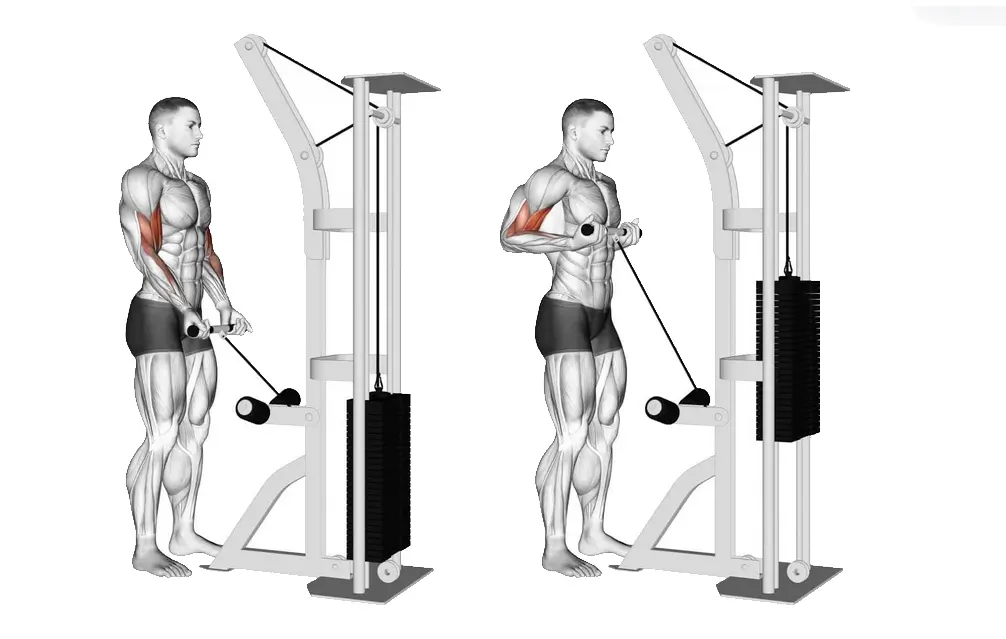
How To Do
- Set up for the cable drag curl by attaching a straight bar to the low pulley cable machine.
- Stand with your feet shoulder-width apart, your knees slightly bent, and your abs are drawn in.
- Grab the bar with a double underhand (supinated) grip, with your hands slightly wider than shoulder-width apart.
- Bring your elbows and shoulders back slightly as you curl the bar upwards. It should feel like you are “dragging” the dumbbell up to your body.
- Squeeze your biceps hard at the top and slowly return to the starting position.
Know More: Drag Curls: Muscle Worked, Benefits And Variation
8. One Arm Cable Curl
When doing a bicep workout with a cable machine, you can add plenty of single-arm exercises to correct potential imbalances.
If there’s an imbalance between your left and right biceps, cable one-arm curls can help correct it. Since each arm works independently, you can identify and address strength disparities between the sides.

How To Do
- Attach a stirrup bar to a low cable pulley.
- Stand on the side of the weight stack with your legs shoulder-width apart and your knees slightly bent.
- Grasp the stirrup in one hand with an underhand grip (palms facing up).
- Your non-lifting arm should be grabbing your waist. This allows you to keep your balance.
- Curl the stirrup up towards your chest while keeping your elbows still.
- Slowly lower the stirrup to the starting position.
- Do 8-12 reps and then switch the arm.
9. Cable Squatting Curl
This exercise is great if you don’t have a desk or if it’s occupied in your gym. The advantage of this variation is that it allows you to work with constant tension throughout the movement thanks to the pulley.
The study has shown that the concentration curl had the greatest EMG activity, followed by the hammer curl and the preacher curl.
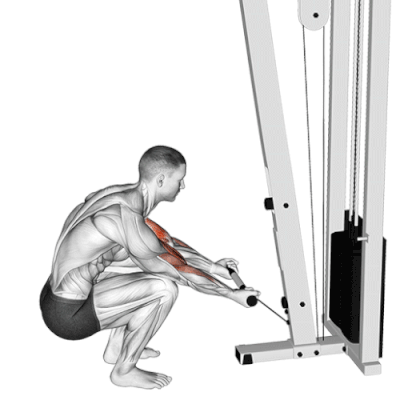
How To Do
- Set up for the cable squatting curl by attaching a straight bar to the low pulley cable machine.
- Squat straight down, so your buttocks are touching your heels.
- Rest the back of your arms (just behind the elbows) on your knees.
- Your knees will act as padding to really isolate the biceps.
- Grab the bar with a double underhand (supinated) grip, slowly curl the bar up towards your body as far as possible.
- Squeeze the biceps, and then slowly lower the weight back to the starting position.
- You don’t need to use as much weight as normal because you’re really isolating the bicep and the movement is much harder than a cable curl.
Know More: Best Back and Bicep Workout for Muscle Growth
10. Lying Cable Curl
If you’re looking for a way to get more creative with your biceps curls, why not try lying (supine) cable curls?
The point of lying on your back for the lying cable curl is to eliminate all body momentum. Therefore, it’s prevents cheating and better isolate your elbow flexors.
It is performed lying on the back, either on a bench or the ground, with the feet facing toward a cable stack. This movement is usually performed for moderate to high reps for a burn and pump as part of an arm-focused workout.
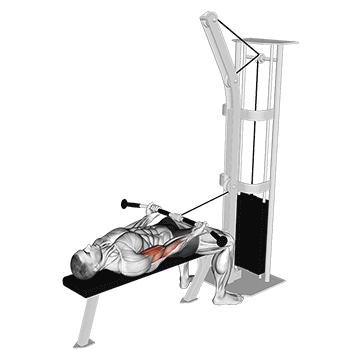
How To Do
- Grab a straight bar or E-Z bar attachment that is attached to the low pulley with both hands using an underhand (palms facing up) shoulder-width grip.
- Lie supine (on your back) on the bench in front of the weight stack with your feet flat against the frame of the pulley machine.
- While keeping your upper arms stationary and your elbows close to your body, curl the bar towards your chest.
- Also, do not allow your body to come off of the floor or bench.
- Slowly return to the start position.
How to Train Bicep With Cable
1. Training Volume (Sets And Reps)
Of course, the number of sets and reps will be determined based on your fitness journey, but here is a great starting point:
The number of reps you should do depends on your goals, whether they are to increase strength or build muscle mass and endurance.
- For muscle growth, it is best to do for around 8–12 reps per set.
- Muscle Endurance, do 15-20+ reps per set.
| Level | Weekly Sets | Reps | Frequency |
|---|---|---|---|
| Beginner | 8-10 | 8-12 | 1-2 times per week |
| Intermediate | 10-15 | 8-12 | 1-2 times per week |
| Advanced | 15+ | 8-15 | 2-3 times per week |
2. How To Add Bicep Cable Exercises In Your Workout Routine
They can be incorporated into your workout routine in a variety of ways. Here are some options:
- As a standalone exercise: Do 3-4 exercises, 3-4 sets of 8-12 reps.
- As part of a back workout: Do 3-4 sets of 8-12 reps and other bicep exercises like the Deadlift and lats pulldown.
- As part of a full-body workout: Do 3-4 sets of 8-12 reps and other compound exercises like squats, deadlifts, and bench presses.
4. Cable Only Bicep Workout Routine
| Exercise | Sets | Reps |
|---|---|---|
| Cable Curl | 4 | 8-10 |
| Cable Hammer Curl | 4 | 8-10 |
| Cable Drag Curl | 3 | 10-12 |
| Cable Reverse Curl | 3 | 10-12 |
5. Bicep Workout Routine
| Exercise | Sets | Reps |
|---|---|---|
| Barbell Curl | 4 | 8-10 |
| Concentration Curl | 3 | 10-12 |
| Cable Hammer Curl | 3 | 8-10 |
| Barbell Reverse Curl | 4 | 8-12 |
6. Pull Workout Routine
| Exercise | Sets | Reps |
|---|---|---|
| Pull-Ups | 3 | 8-10 |
| Plank | 3 | 8-12 |
| Lats Pulldowns | 3 | 10-12 |
| Cable Curl | 3 | 8-12 |
| Barbell Shrugs | 3 | 8-12 |
FAQ
Are cables good for the biceps?
Yes, Cable exercises strengthen your biceps almost as well as other exercises. If you want to increase the size or strength of your biceps muscles, consider adding cable exercises to your routine.
Are cable workouts better than dumbbells?
Cable exercises elicit a more powerful muscle pump than dumbbells because they provide your biceps with constant tension.
Can Bicep cable exercises build muscle?
Cable exercises are a great way to add variety to your workout build strength, and train your muscles from different angles.
Why are bicep cables Workouts better?
“Cables are a lot more fluid and smooth than free weights. Using a series of pulleys means you’re less likely to get hurt, as you don’t directly push or pull against the force of gravity. This puts less stress on your joints for safer sets and reps.
Are cables better for hypertrophy?
Yes, anything from your body weight to dumbbells to cables will help you to build muscle. Any media can yield fast results provided your muscles endure a high enough stimulus to promote hypertrophy.
Can you build biceps with cables?
Yes, it is possible to build biceps with cable exercises. Cable exercises such as cable curls and cable hammer curls can effectively target the biceps.
References & Resources
- Nunes, J.P.; Jacinto, J.L.; Ribeiro, A.S.; Mayhew, J.L.; Nakamura, M.; Capel, D.M.G.; Santos, L.R.; Santos, L.; Cyrino, E.S.; Aguiar, A.F. Placing greater torque at shorter or longer muscle lengths? Effects of cable vs. barbell preacher curl training on muscular strength and hypertrophy in young adults. Int. J. Environ. Res. Public Health 2020, 17, 5859
- Coratella, Giuseppe, Gianpaolo Tornatore, Stefano Longo, Nicholas Toninelli, Riccardo Padovan, Fabio Esposito, and Emiliano Cè. 2023. “Biceps Brachii and Brachioradialis Excitation in Biceps Curl Exercise: Different Handgrips, Different Synergy” Sports 11, no. 3: 64. https://doi.org/10.3390/sports11030064
- Staudenmann D, Taube W. 2015. Brachialis muscle activity can be assessed with surface electromyography. Journal of Electromyography and Kinesiology 25(2):199-204
- Muscle and Strength: Cable Only Bicep and Tricep Workout
- American Council on Exercise: “6 Benefits of Using Weightlifting Machines

Manish is a NASM-certified fitness and nutrition coach with over 10 years of experience in weight lifting and fat loss fitness coaching. He specializes in gym-based training and has a lot of knowledge about exercise, lifting technique, biomechanics, and more.
Through “Fit Life Regime,” he generously shares the insights he’s gained over a decade in the field. His goal is to equip others with the knowledge to start their own fitness journey.
